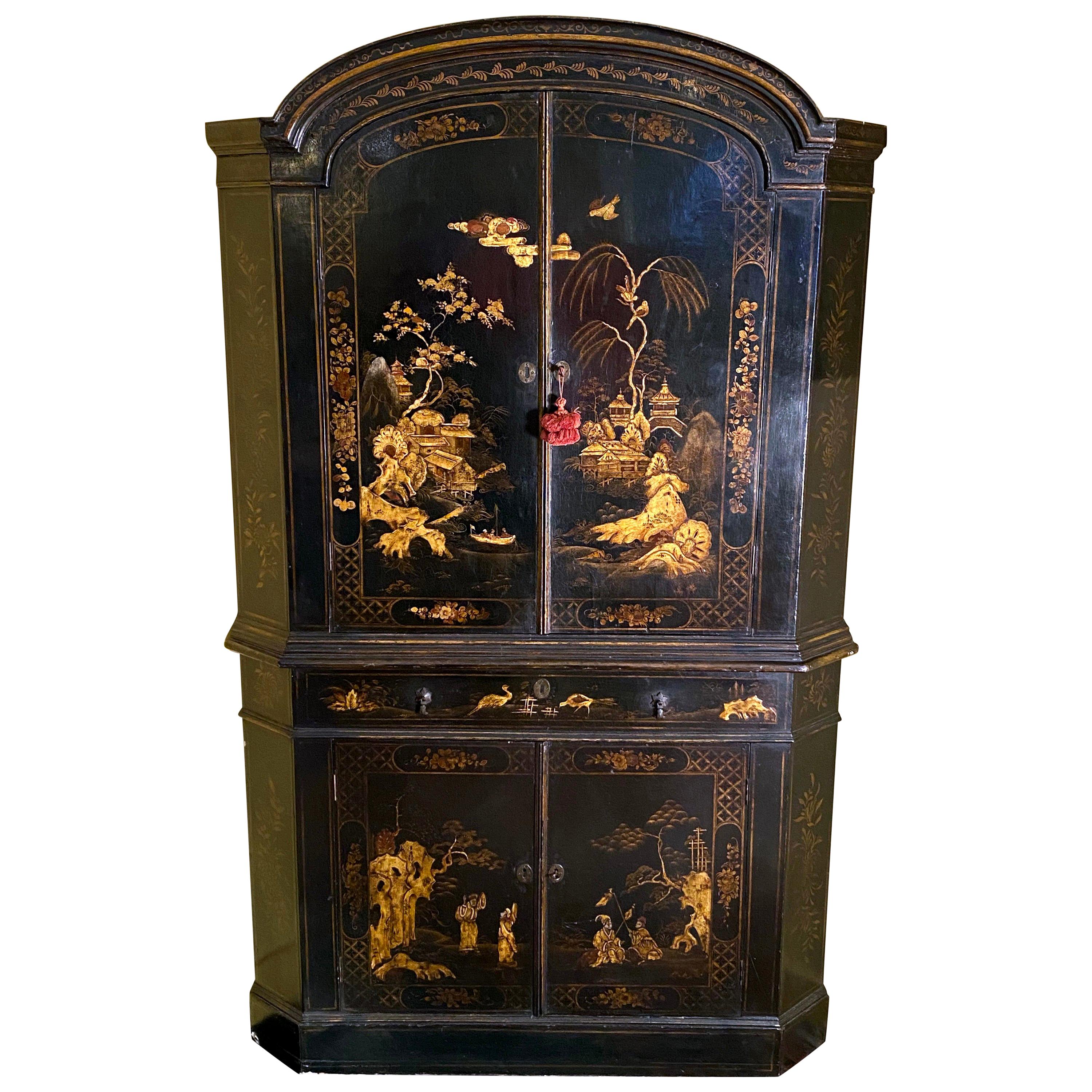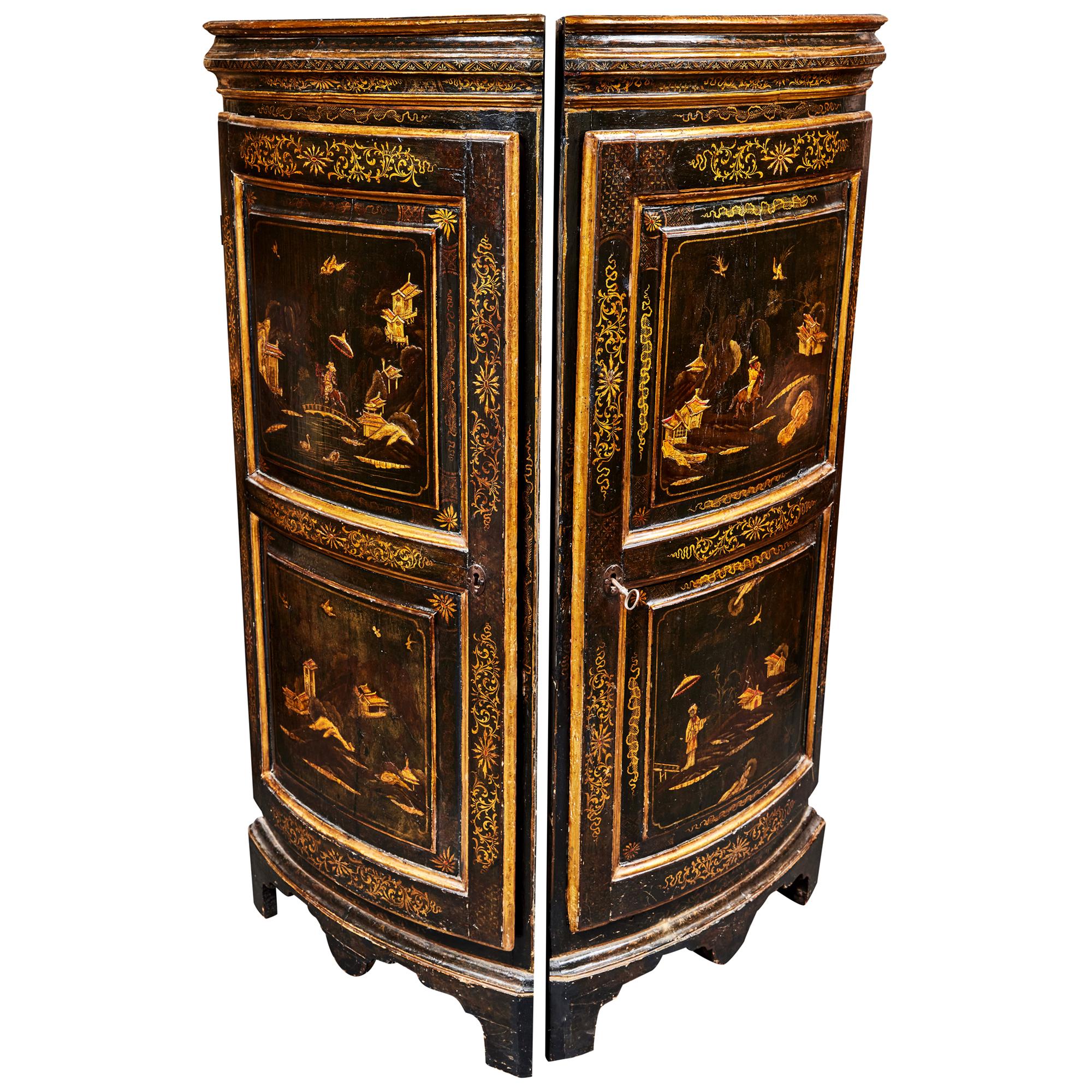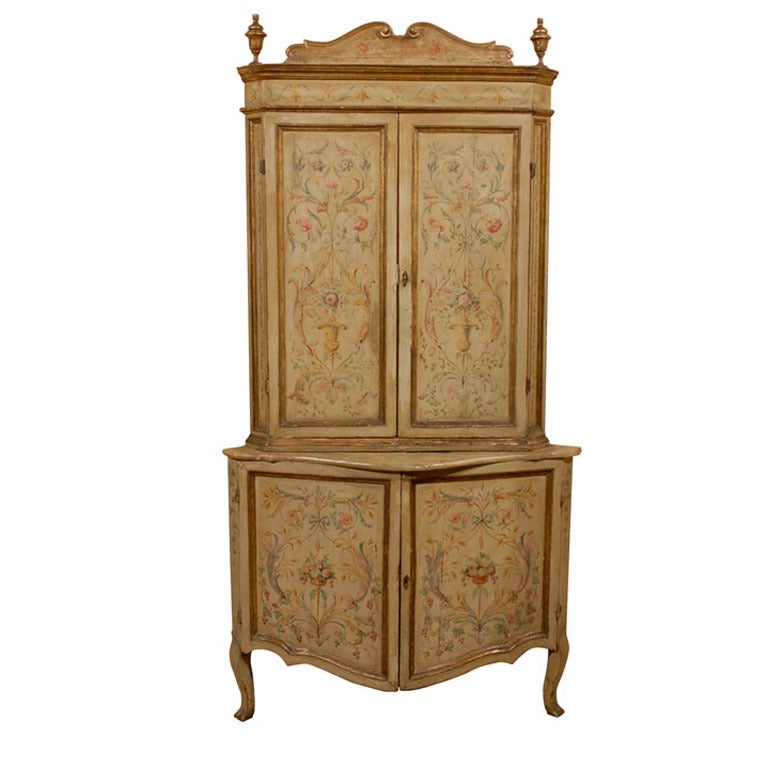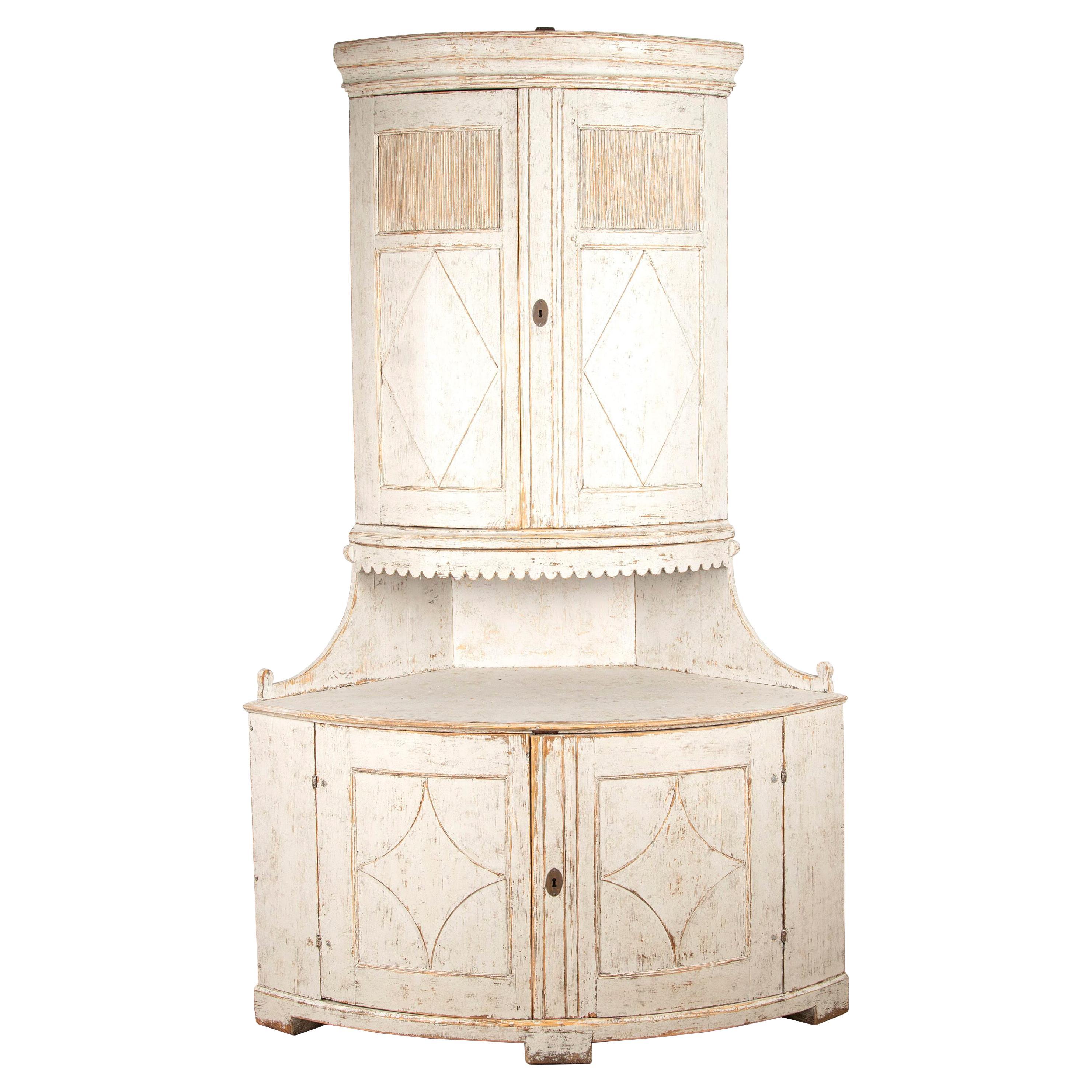Items Similar to Early 18th Century Coromandel Lacquer Corner Cabinet
Video Loading
Want more images or videos?
Request additional images or videos from the seller
1 of 16
Early 18th Century Coromandel Lacquer Corner Cabinet
About the Item
An early-18th century Coromandel lacquer corner cupboard or cabinet.
This is rare - high quality Coromandel lacquer work (incised decoration) - not to be confused with the usual English japanned versions.
This is also referred to as Bantam work, originating in Bantam, Dutch East Indies, and China, for export to the European market.
The subject matter is of a major pavilion with numerous courtiers - most unusual to see only females - it has been suggested that they may be concubines to a Mandarin.
All of high quality and in the sought-after and refined chinoiserie taste.
In very good unrestored state, retaining vibrant colours and all its original hardware. This is a chic antique, and makes a lovely chinoiserie drinks cabinet, with two fitted shelves.
Ready to use.
Measures:
H: 79 cm (31 1/4’')
W: 57.5 cm (28 1/2’’) max
D: 31.5 cm (12 1/2’')
The fashion icon Coco Chanel had a large collection of Coromandel lacquer items in her Parisian apartments.
References:
Wikipedia-
Coromandel lacquer is a type of Chinese lacquerware, latterly made mainly for export. Referred to as such only in the West because it was shipped to European markets via the Coromandel coast of South-East India, where the Dutch East Indies Company (VOC) and its rivals from a number of European powers had bases in the 18th century.
In 18th-century England Bantamwork signified a particular style of export lacquerware which was cut into a layer of gesso, and then lacquered in colours.
A Technical Study on Chinese Lacquer Technology: Case
UCL - archaeology - events 2018 Dec.
Coromandel lacquer is also known as kuancai and shenke in Chinese. It is a type of polychrome lacquer where designs carved into the smooth lacquer surface were filled with painted colours. The technique has a relatively short manufacturing history and limited written record. Most of its surviving examples are found in European collections.
- Dimensions:Height: 31.11 in (79 cm)Width: 22.64 in (57.5 cm)Depth: 12.41 in (31.5 cm)
- Materials and Techniques:
- Place of Origin:
- Period:
- Date of Manufacture:circa 1700
- Condition:In lovely unrestored state and ready to use. This makes a lovely antique chinoiserie drinks cabinet.
- Seller Location:Lymington, GB
- Reference Number:
About the Seller
5.0
Vetted Seller
These experienced sellers undergo a comprehensive evaluation by our team of in-house experts.
Established in 1957
1stDibs seller since 2018
33 sales on 1stDibs
Typical response time: 15 hours
- ShippingRetrieving quote...Ships From: Lymington, United Kingdom
- Return PolicyA return for this item may be initiated within 14 days of delivery.
More From This SellerView All
- Early 18th Century Japanned Double Corner CabinetLocated in Lymington, GBA rare chinoiserie standing double corner cabinet, or cupboard. English, George I period, ca 1720. Often erroneously referred to as lacquer work, this is in fact japanned. Beautifully decorated with idyllic scenes of rockwork, pagodas, people, trees, birds, water, with bridges and a boat. This is a lovely and very useful addition to a room - where corners can present furnishing dilemmas - and this is an ideal antique drinks cabinet. These have always been very hard to find, as opposed to the more usual Georgian hanging corner cupboards...Category
Antique Early 18th Century English George I Cabinets
MaterialsLacquer
- 18th Century Mahogany Secretaire Bookcase China CabinetLocated in Lymington, GBA fine English mid-18th century mahogany secretaire / secretary / bookcase / china cabinet. Of lovely, deep, rich color, patina and quality. George III period, circa 1760. The bold, detachable, swan-neck pediment carved with 'Gothic' open fretwork, spiral rosettes and a dentil cornice. The pediment is centred by a small platform below which is a fluted panel. The bookcase / china cabinet section with two, thirteen-pane glazed doors, with three original adjustable shelves with applied beadings for the display of china etc. The base with a pull-out writing section fitted with small drawers, two of which have secret releases. These secret drawers are faced with blind-fret 'Gothic' tracery, and centred by a carved, shaped arch. The base with three cock-beaded drawers, and raised on its original bracket feet which are faced with blind fret. This fine, sophisticated and well-proportioned example of a secretaire / secretary / cabinet / desk / bookcase is remarkable for having survived in its original state including all swan-neck handles and locks. Of superb quality, color, patination, and well figured throughout. With mahogany drawer linings: further confirmation of its quality. Measures: 42" wide (107 cm) 23" deep 58.5 cm) 95" high (241 cm) - without cartouche. A related antique bureau cabinet...Category
Antique 1740s English Cabinets
MaterialsMahogany
- Early 18th Century Geometric-Front Chest on ChestLocated in Lymington, GBAn English early-18th century oak geometrically-panelled chest on chest ca 1710-1720. Queen Anne / George I period. NB. This is an interesting example of a transition from the late ...Category
Antique 18th Century British Queen Anne Commodes and Chests of Drawers
MaterialsOak
- 19th Century Venetian Rococo Lacquer CabinetLocated in Lymington, GBAn antique Venetian rococo japanned (or 'lacquer') cabinet. This rare and sophisticated antique cabinet separates in two, with bombé and serpentine profiles. The particularly fine ...Category
Antique Mid-18th Century Rococo Cabinets
MaterialsLacquer
- Small Size Mid-18th Century Mahogany Bureau Bookcase or CabinetLocated in Lymington, GBA small mid-18th century mahogany bureau bookcase or cabinet. George II period, circa 1740. This diminutive Georgian bureau bookcase (also s...Category
Antique 18th Century Bookcases
MaterialsMahogany
- Rare Chinese Kangxi Polychrome Coromandel Lacquer CasketLocated in Lymington, GBA rare Chinese polychrome Coromandel or ‘Bantam Ware’ lacquer casket or table cabinet, Kangxi period (1661-1722). Circa 1700. This fine small Chinese export lacquer fitted casket is decorated overall with polychrome incised decoration. Opening with two doors revealing a red interior with fitted drawers and a hinged rising top. In superb, almost entirely original condition, retaining its vivid colours and fine details with courtiers in a pavilion and on horseback amidst foliage and formal palace gardens. The small bun-type feet are historical replacements. Interestingly bearing an antique-script inventory #25 and A I on the base. Nb. Bantamwork or Coromandel lacquer, not to be confused with ‘japanning’, is the term applied to decoration that is cut into a layer of gesso and then lacquered in colours. Much of the lacquer was transhipped from China through Coromandel in India, or the Dutch colony Batavia, Java. References: Coromandel lacquer or ‘Bantamwork’, with its characteristic incised decoration, was made in Henan province in northern China from the latter part of the Ming dynasty and exported to Europe from the end of the 17th century through the East India Company’s and VOC trading posts on the Coromandel coast of India. The technique consisted in overlaying a base of wood with a series of increasingly fine white clays and fibrous grasses. Over this surface, lacquer was applied and polished before the design was incised and the hollowed out portions filled with colour and gilt and finished with a clear lacquer to protect it. Although John Stalker and George Parker used the term ‘Bantamwork’, the contemporary layman usually called it ‘cutt-work’, ‘cutt Japan’ or ‘hollow burnt Japan’. Stalker and Parker discuss two types of ‘Bantam-work’ – flat and incised – in their Treatise on Japanning and Varnishing of 1688, noting that it ‘was done in colorus mix’t with a gum water’. They also considered that it was ‘almost obsolete, and out of fashion, out of use and neglected….’ although admitted that ‘it was very pretty, and some are more fond of it, and prefer it to the other…’. This casket/ table cabinet now on offer is related to one formerly with Malletts and illustrated in A. Bowett, 'English Furniture 1660-1714: From Charles II to Queen Anne', Woodbridge, 2002, p. 150, plates 5:9. A much larger closely-related Bantam work coffer with rising lid was offered in the ‘Asian Art in Cologne’ sale lot 114 on 11th December 2021. Estimated @ £60,000 – £79,000. Mme de Pompadour, mistress to King Louis XV from 1745 to 1751, was an avid collector and admirer of Chinese Coromandel or Bantam work and was probably largely responsible for the very high prices recorded for such pieces, sometimes 10 times or more the price of ordinary furniture of equivalent quality. A Coromandel cabinet...Category
Antique 18th Century Chinese Cabinets
MaterialsLacquer
You May Also Like
- 18th Century English Lacquered Gilt Chinoisoire Corner CabinetLocated in Savannah, GAEnglish corner cabinet, made circa 1780, in lacquered gilt chinoisoire. Stunningly beautiful lacquered gilt chinoisoire on a black ground. Bracket feet to the base. 13 pane astrical ...Category
Antique 18th Century and Earlier British George III Cabinets
- 18th Century Baroque Corner CabinetLocated in Tetbury, GloucestershireAn exceptional unusual period Baroque corner cabinet, carved pediment, decorative detailing to all the doors, original hinges and locks in tinned iron, measurement from the corner al...Category
Antique 18th Century Swedish Baroque Cabinets
MaterialsWood
- 18th Century, Chinoiserie Corner CabinetsLocated in Newport Beach, CAA pair of elegant, ebonized, lacquered, hand painted and parcel gilt, Chinoiserie decorated corner cabinets. Doors featuring two panels painted with unique scenes and embellished wit...Category
Antique 1760s Italian Cabinets
MaterialsWood
- 18th century Italian Painted Corner CabinetLocated in Atlanta, GAA late 18th century Italian painted and gilt Corner Cabinet with serpentine shape and floral decoration, ca. 1780 William Word Fine Antiques: Atlanta's source for antique interior...Category
Antique Late 18th Century Italian Corner Cupboards
MaterialsPaint
- Large 18th Century Swedish Corner CabinetLocated in Tetbury, GloucestershireExceptional 18th century corner cabinet. The top section features a simply carved pediment that supports two wonderfully carved diamond decorations to the doors. To the top are t...Category
Antique 18th Century Swedish Cabinets
MaterialsWood
- 18th Century Italian Painted Corner CabinetLocated in Houston, TX18th century Italian painted corner cabinet. This stunning antique Italian two part corner cabinet, cupboard or duex corp with original painted finish is simply stunning. This Tusca...Category
Antique 18th Century Italian Louis XVI Corner Cupboards
MaterialsWood
Recently Viewed
View AllMore Ways To Browse
Type Case
Fashion Storage
Lovely Antique Cabinet
18th Century Carved Cabinet
Short Cabinet
Antique Cabinet 18th
18th Century Kitchen Cabinet
Ships Cabinet
18th Century English Cabinet
High Lacquer Cabinet
Chinese Lacquer
Type Cabinet
Large Cabinet Hardware
Large Lacquer Cabinet
Antique Painted Corner
Antique Style Cabinet Hardware
Antique Style Corner Cabinet
Max England





